Austrian Airlines Grouses About Chinese Carriers’ Growing Dominance
VIENNA—Austrian Airlines reported solid third quarter (Q3) results but sees issues ahead, such as the growing advantage held by Chinese carriers coupled with high costs in Austrian’s main markets.

VIENNA—Austrian Airlines reported solid third quarter (Q3) results but sees issues ahead, such as the growing advantage held by Chinese carriers coupled with high costs in Austrian’s main markets.
During a Q3 results presentation on Oct. 29 in Vienna, Austrian Airlines CEO Annette Mann said the airline also faces geopolitical uncertainties, ongoing operational challenges and a significant cost burden from flight cancellations and delays. Costs caused by irregularities stand around 60% higher than this time last year, mainly due to the tense situation in the Middle East and air traffic control issues in Hungary’s airspace, which is close to Austrian’s Vienna International Airport hub.
“A new topic now is the competition with airlines from China,” Austrian chief commercial officer Michael Trestl told Aviation Week at the event. “We see that capacity from Chinese carriers is increasing; not to say that the European market is flooded,” he said. The additional capacity from Chinese airlines combined with their lower cost structures and competitive advantage in being able to fly shorter, more direct Europe-Asia flights via Russian airspace is making life harder for airlines like Austrian. Chinese carriers are not only increasing their share of Europe to China traffic but also to other Asian destinations. “This is certainly a challenge that we will face even more clearly in the coming years,” Trestl added.
Elsewhere, the Middle Eastern market, historically important for Austrian, has been hard for the airline. Flights to destinations like Tehran in Iran, Erbil in Iraq, Amman in Jordan and Tel Aviv have been halted for now. Vienna has notably been an important hub for those traveling between Iran and the U.S. “It is painful that these [destinations] have to be suspended. This hurts Austrian Airlines more than any other airline in the Lufthansa group,” Trestl added.
Regarding the increasing presence of carriers like Turkish Airlines or Emirates, Mann said, this is a process that has existed for 20 years.
“Twenty years ago, traffic from Europe to Asia, for example, has been shared, 40% by European airlines, 60% by Asian carriers. Middle East carriers did not play a major role in those days with a share of about 3%,” Mann told Aviation Week. Now, European carriers’ traffic share is down to 20% and Asian carriers are at 30%. “So, we lost 50% of this market to those carriers,” she said.
Fleet Update
Austrian Airlines is undergoing a long-haul fleet refresh, replacing its aging fleet of Boeing 767-300 and 777-200ERs with 11 787-9s by 2028. The first two of those 787s arrived this year, instead of 2023 as planned. With parent Lufthansa Group struggling to get 787s for flagship carrier Lufthansa Airlines, Austrian COO Francesco Sciortino told Aviation Week that the airline can “expect our third 787 in September 2025.” Austrian’s last 767-300 should leave the fleet in 2026 after another 14 to 15 months in operation, Sciortino added.
On the narrowbody side, Austrian Airlines will wet-lease up to three Airbus A220-300s from Lufthansa Group partner airBaltic to fill capacity gaps in summer 2025 as some of its Pratt & Whitney GTF-powered A320neo-family aircraft will be out of action due to engine issues. “We are doing the planning now for summer 2025,” Trestl said. “The wet leases will operate on selected routes.”
The Lufthansa Group will receive the first of 40 737-8s in 2027 after placing a firm order in December 2023. The Boeing narrowbody will not operate for Swiss International Air Lines or the Lufthansa mainline, and Sciortino says that the aircraft may not be a good fit for Austrian’s needs. He notes that the 737 MAX does not have a cargo loading system to handle luggage containers, meaning baggage has to be handled by personnel instead. He said that for an airline which has a hub operation with a lot of transfer passenger this creates disadvantages. “The final decision has not been made so far where the 737 MAX fleet will operate, but we do not think that it will join Austrian,” he said.
During Q3 2024, Austrian Airlines operated 68 aircraft and transported 4.7 million passengers, an increase of 5% on Q3 2023. Revenues increased 6% to €811 million ($876 million).
“We are actually quite satisfied with the third quarter,” Mann said. “But with an EBIT of €77 million (-49%) for the first nine months, we are not so happy. This resulted in a weak first half of the year.”
In summer 2025, Austrian Airlines will add new services from Vienna to Burgas (Bulgaria), Edinburgh, Evenes (Norway) and Sylt (Germany).


